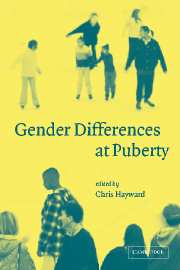Book contents
- Frontmatter
- Contents
- List of figures
- List of tables
- List of contributors
- Preface
- Acknowledgments
- 1 Methodological concerns in puberty-related research
- Part 1 Sex differences in hormones and their effect at puberty
- Part 2 Girls at puberty
- 4 Puberty and body image
- 5 Gender differences in opposite sex relationships: interactions with puberty
- 6 Aggression, psychopathology, and delinquency: influences of gender and maturation – where did all the good girls go?
- Part 3 Boys at puberty
- Part 4 Puberty and psychopathology
- Part 5 Pubertal timing: antecedents
- Part 6 Pubertal timing: consequences
- Part 7 Puberty and context
- Index
- References
5 - Gender differences in opposite sex relationships: interactions with puberty
Published online by Cambridge University Press: 22 September 2009
- Frontmatter
- Contents
- List of figures
- List of tables
- List of contributors
- Preface
- Acknowledgments
- 1 Methodological concerns in puberty-related research
- Part 1 Sex differences in hormones and their effect at puberty
- Part 2 Girls at puberty
- 4 Puberty and body image
- 5 Gender differences in opposite sex relationships: interactions with puberty
- 6 Aggression, psychopathology, and delinquency: influences of gender and maturation – where did all the good girls go?
- Part 3 Boys at puberty
- Part 4 Puberty and psychopathology
- Part 5 Pubertal timing: antecedents
- Part 6 Pubertal timing: consequences
- Part 7 Puberty and context
- Index
- References
Summary
Pubertal maturation is the single most salient developmental change occurring during adolescence (Alsaker, 1996; Hayward, Killen, and Wilson, 1997). Puberty is unique in that it includes biological changes associated with the physical transition from a child's body to that of an adult, however, these changes also occur within a societal context that confers value upon this process (Graber, Petersen, and Brooks-Gunn, 1996). These physical changes take place against a backdrop of simultaneous changes occurring in a number of major domains of an adolescent's life (Brooks-Gunn and Graber, 1994). How these transitions interact may have implications for adjustment over time (Lerner, 1996; Lerner, et al., 1996).
Although researchers are paying increased attention to the study of romantic involvement with the opposite sex during adolescence (Brown, Feiring, and Furman, 1999), relatively little work has been completed to link this body of literature with the preexisting research assessing the association between puberty and patterns of adjustment. Given that pubertal processes are directly related to physical and psychological sexual maturity (Brooks-Gunn and Reiter, 1990), it is important that researchers strive to understand the nature of these changes in relation to involvement with the opposite sex and how these interactions inform well-being. This chapter seeks to fill the gap by examining these associations as they vary by gender. Where possible, we will consider the influences of different forms of opposite sex involvement, because much of the research in this area has emphasized romantic relationships. This chapter will also reflect this trend.
- Type
- Chapter
- Information
- Gender Differences at Puberty , pp. 77 - 92Publisher: Cambridge University PressPrint publication year: 2003
References
- 4
- Cited by

